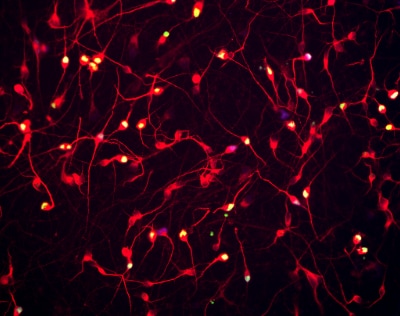Protocol Guide: Cortical Glutamatergic Neuron Monoculture
What are Glutamatergic Neurons?
Glutamatergic neurons produce glutamate, one of the main excitatory neurotransmitters in the central nervous system (CNS). These neurons are involved with learning and memory functions and are used to develop therapeutics for diseases such as Alzheimer’s disease, Huntington’s disease, epilepsy, Parkinson’s disease, and more.
In partnership with BrainXell, we provide excitatory glutamatergic neurons of a forebrain lineage representative of various deep layers of the cortex (Layers V and VI). They are fully differentiated, express FOXP2 and MAP2 at DIV7 with synchronous firing by DIV21, and primarily release the neurotransmitter glutamate. Here we describe a protocol for seeding and culturing cortical glutamatergic neurons.
Section Overview
Glutamatergic Neuron Culture Materials
Immediately transfer the neuron cryovials to a liquid or vape nitrogen storage system. Store BrainFast supplements at -20°C for up to 6 months or -80°C for up to 18 months.
- BrainXell Human Cortical Glutamatergic Neurons (BX-0300-30-5M or BX-0300-30-1M)
- BrainFast Glutamatergic Seeding Supplement (BX-2300-100uL)
- BrainFast D4/Day 4 Supplement (BX-2040-100uL)
- BrainFast SK/Supplement K (BX-2020-100uL)
- DMEM/F12 Medium, +L-glutamine, +HEPES (D0697)
- Neurobasal Medium (Thermo Fisher Scientific #21103049)
- B-27 Supplement (Thermo Fisher Scientific #17504044)
- N-2 Supplement (Thermo Fisher Scientific #17502048)
- GlutaMAX Supplement (Thermo Fisher Scientific #35050061)
- Cultrex (R&D Systems #3432-001-01)
- Ascorbic Acid (A8960)
- PDL-coated 96-Well Plate (M0812, LPDL001)
Glutamatergic Neuron Culture Protocol
Day 0: Seeding Preparation
For a 96-well plate seed 3.3 - 4.4 million live cells, but additional cells can be used depending on experimental needs. For viability and seeding information see the Certificate of Analysis (CoA).
- Combine components listed below to make Basal Medium in the cell culture hood or biological safety cabinet. Allow medium to come to room temperature for 15 minutes; do not place in a 37°C water bath. Basal medium stock can be stored at 4°C for up to 3 weeks.
- The addition of growth factors is optional – recommended final concentrations are: 2µg/ml TGF-β1, 10µg/ml BDNF, and 10µg/ml GDNF.
- Prepare a pre-diluted Cultrex solution. Add 495µl of cold DMEM/F12 medium to a 55µl aliquot of frozen Cultrex taken directly from the -80°C freezer and mix to dissolve. This solution can be stored at 4°C.
- Prepare solutions for cell seeding. Add 3ml of Basal Medium to a 50ml conical tube and 25µl of Trypan Blue solution to a separate microcentrifuge tube for cell counting.
Day 0: Seeding the Glutamatergic Neurons
- Place a cryovial of glutamatergic neurons in a 37°C water bath to thaw. Be sure to not submerge the cap.
- Remove the vial from the water bath as the last of the ice melts and disinfect the vial with 70% ethanol. Transfer the vial to the cell culture hood.
- Using a P1000 pipette at a rate of 2-3 drops/sec, transfer 500µl of the Basal Medium from the 50ml conical tube to the glutamatergic neuron vial. This process should take about 10 seconds.
- Transfer the 1ml contents in the cell cryovial to the 50ml conical tube.
- Centrifuge the cells at 465xg for 5 minutes.
- Aspirate the supernatant and resuspend the cell pellet in 950µl fresh Basal Medium by using a P1000 pipette to gently pipette up and down.
- Resuspend the cells to a final concentration of 1.0 x 106 live cells/ml based on the CoA value. Slowly add Basal Medium to the existing 1ml in the conical tube to get to the desired concentration.
- For example, 5.3 million viable cells/vial is diluted to 5.3 final volume.
- Count the cells using the prepared Trypan Blue solution. Pipette up and down 3-5 times to evenly suspend cells in the Basal Medium and transfer 25µl of the cell suspension to the microcentrifuge tube filled with 25µl Trypan Blue solution. Mix by pipetting up and down. Using a hemocytometer, count the number of viable and dead cells and determine the live cell concentration and viability.
- Calculate the volume needed to create a glutamatergic neuron seeding suspension. The typical seeding density is 30,000-40,000 viable cells/100µl/well for a 96-well plate (~93,750-125,000 viable cells/cm2), but the recommended seeding density may vary (refer to the CoA for lot-specific seeding information). Dilute the cells to the desired seeding concentration based on previous Trypan Blue cell count.
Example dilution calculation:
- In a new conical tube, mix the previously calculated volumes of the glutamatergic neurons and the Basal Medium to obtain 11ml of the glutamatergic neuron seeding suspension.
- Make the Seeding Medium for the glutamatergic neurons:
- Completely mix and transfer the final Seeding Medium to a PDL-coated 96-well plate at 100µl/well. Do not move the plate during the seeding process – this can lead to uneven attachment.
- Rest plate for 10 minutes after seeding to allow the cells to settle. Move plate to a humidified incubator set at 37°C with 5% CO2.
This protocol should not exceed 1 hour. The post-thaw health and viability of the cells can be impacted if the process is too long.
Day 1: Glutamatergic Neuron Medium Replacement
- Prepare Day 1 Medium:
- Remove 100µl medium/well and replace with 100µl medium/well – complete one row or column at a time so the wells do not dry out.
Day 4: Glutamatergic Neuron Medium Replacement
- Prepare Day 4 Medium:
- Add 100µl medium/well of the Day 4 Medium for a final volume of 200µl medium/well
Day 7 and Onward: Glutamatergic Neuron Medium Changes
- Change half of the media weekly, i.e. on Day 7, 14, 21, etc., using the Basal Medium. Aspirate 100µl/well and slowly add 100µl/well of Basal Medium to the entire plate.
- The addition of low concentration BrainFast SK (0.1-0.5X) in the medium may be helpful for long-term cultures.
Glutamatergic neurons mature rapidly and can be maintained in culture under the above conditions for at least 3 weeks post-seeding.

Figure 1.Immunofluorescent microscopy image of cortical glutamatergic neurons.
Related Products
These products are available in only the US and UK.
如要继续阅读,请登录或创建帐户。
暂无帐户?